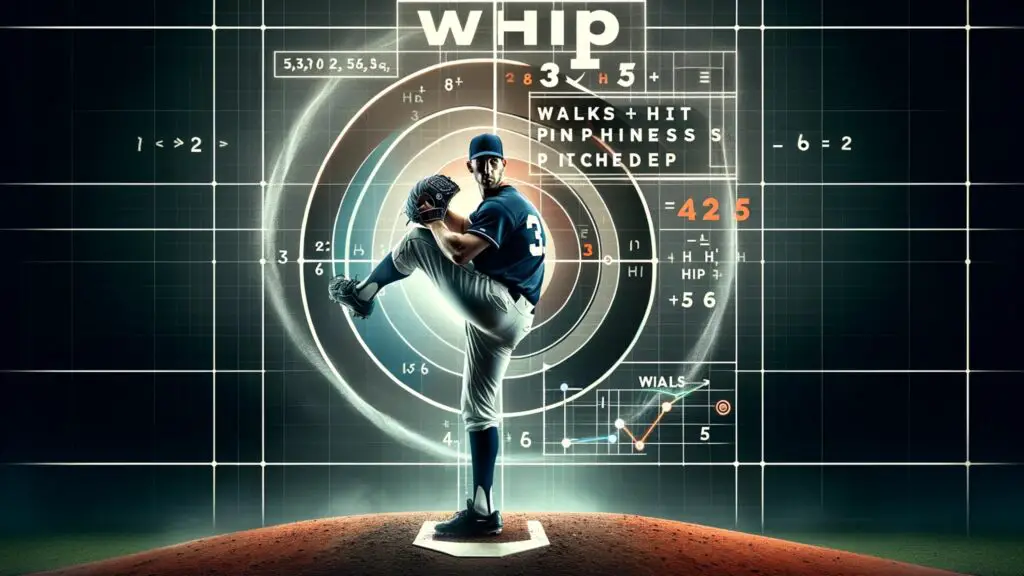
In this article:
When the crack of a baseball bat meets the rawhide of the ball, it’s not just the spectators holding their breath. The pitchers also hope their WHIP statistics don’t take a hit.
So, exactly what is WHIP in baseball? It’s an acronym for Walks plus Hits per Inning Pitched, and it’s a key metric used to measure a pitcher’s effectiveness. Think of it as the baseball equivalent of a report card for pitchers.
In the ever-evolving game of baseball, numbers have become more than just a way to keep score. They’ve become a language all their own, helping coaches, players, and fans alike understand the game on a deeper level.
In this language, WHIP speaks volumes about a pitcher’s performance.
Understanding the Basics of WHIP in Baseball
If you’re a baseball enthusiast or an aspiring player, you’ve probably come across the term ‘WHIP’ in stat sheets and analysis reports. But what exactly is WHIP, and why is it so important in baseball? Let’s dive into the basics.
WHIP, short for Walks plus Hits per Innings Pitched, is a performance statistic in baseball that measures the number of base runners a pitcher has allowed per inning pitched.
It’s a crucial metric because it indicates how well a pitcher prevents opposing players from reaching base, a fundamental game aspect.
How to Calculate WHIP?
The calculation of WHIP is straightforward. You need to divide the number of walks and hits allowed by the number of pitched innings. The formula looks like this:
- WHIP = (Walks + Hits)/Innings Pitched
A lower WHIP score means a pitcher is more successful in keeping opposing players off the bases, making him more effective.
While discussing WHIP and its implications on a pitcher’s performance, it’s also beneficial to understand RBI in baseball, a key statistic that highlights a batter’s effectiveness in bringing runners home.
Why is WHIP Important?
WHIP is an essential statistic in baseball for several reasons:
- It provides a clear picture of a pitcher’s efficiency and effectiveness.
- It gives a better understanding of a pitcher’s ability to prevent base runners than traditional metrics like Earned Run Average (ERA).
- It’s a valuable tool for player evaluation and comparison.
Despite being a relatively recent addition to baseball statistics (first introduced in the late 1970s), WHIP has gained substantial recognition among fans and professionals for its apt representation of a pitcher’s skill.
Next time you examine baseball stats, pay attention to WHIP, and you’ll have a more nuanced understanding of a pitcher’s performance.
Why is WHIP Important for Pitchers?
As a baseball enthusiast, you might wonder why WHIP is important for pitchers. WHIP, which stands for Walks plus Hits per Inning Pitched, is a vital statistic in baseball, particularly for evaluating a pitcher’s performance. Here’s why:
- Indication of control: WHIP measures the number of base runners a pitcher allows per inning. A lower WHIP indicates a pitcher with reasonable control over the game, limiting opponents’ chances to score.
- Predicting performance: WHIP can help predict a pitcher’s future performance. A consistently low WHIP often translates to a lower ERA (Earned Run Average), a key statistic in baseball. It’s not a foolproof predictor, but it’s a reliable one.
- Comparing pitchers: WHIP is a valuable tool, especially those from different eras. As it measures a universal aspect of the game – preventing base runners – it’s an effective comparison tool.
It’s important to note that WHIP, like all statistics, should not be viewed in isolation. It is one piece of the puzzle in evaluating a pitcher’s overall performance and potential.
Other metrics, such as ERA, strikeout rates, and win-loss records, also play a critical role.
So, when assessing your favorite pitcher’s performance or debating which pitcher is the best with friends, don’t forget to consider WHIP. Armed with this knowledge, you’re on your way to becoming a baseball connoisseur.
Calculating WHIP: An In-Depth Look
Before fully understanding WHIP, you first need to understand what it measures. WHIP, or ‘Walks plus Hits per Inning Pitched’, is a statistical measure used in baseball to evaluate a pitcher’s performance.
This statistic measures the average number of walks and hits a pitcher allows per inning pitched. So, how exactly is WHIP calculated? Let’s dive a little deeper.
Understanding WHIP: The Basics
The calculation for WHIP is quite straightforward. It involves adding the number of walks (BB) and hits (H) that a pitcher allows and then dividing this total by the number of innings pitched (IP). This is often expressed as:
- WHIP = (Walks + Hits) / Innings Pitched
Importance of WHIP in Evaluating Performance
Why is WHIP such a crucial statistic in baseball? But, it gives a clear picture of a pitcher’s ability to prevent batters from reaching base, an essential skill in the game.
A lower WHIP indicates that the pitcher effectively keeps opponents off base, while a higher WHIP suggests they may struggle in this area.
Interpreting WHIP Scores
In general, a WHIP of less than 1.00 is considered excellent, indicating that the pitcher, on average, allows less than one hitter to reach base per inning. A WHIP between 1.00 and 1.25 is considered good, while a WHIP between 1.25 and 1.50 is average. Anything above 1.50 is typically viewed as poor.
Limitations of WHIP
While WHIP is undeniably an important statistic, it has limitations. Most notably, WHIP doesn’t consider the outcomes of a batter reaching base – whether it’s a home run or a single, they’re both counted the same.
Additionally, WHIP doesn’t factor in a pitcher’s ability to prevent runs once batters have reached base.
In conclusion, WHIP provides a straightforward, easy-to-understand measurement of a pitcher’s effectiveness. Considering both walks and hits, it delivers a balanced evaluation of a pitcher’s performance, making it a valuable tool for any baseball enthusiast or analyst.
As we explore the nuances of WHIP and its impact on the game, it’s interesting to consider the experience of watching these strategic plays unfold from box seats at a baseball game, which offer some of the best views and a unique perspective on the pitcher’s duel.
Key Differences Between WHIP and ERA
While WHIP and ERA are critical metrics in baseball, several key differences exist to understand. Let’s dive deeper to get a clearer picture.
Conceptual Difference
WHIP, or Walks plus Hits per Inning Pitched, measures how many base runners a pitcher has allowed per inning. Conversely, ERA, or Earned Run Average, quantifies the average number of earned runs a pitcher gives up in a nine-inning game.
Calculation
The methods of calculation for WHIP and ERA are distinctive. For WHIP, you add the number of walks and hits a pitcher allows, then divide by the number of innings pitched.
On the other hand, the ERA is calculated by dividing the total number of earned runs by the total number of innings pitched, then multiplying by nine.
Implication
WHIP is an excellent indicator of a pitcher’s overall effectiveness, considering both hits and walks. A lower WHIP indicates a more effective pitcher. However, ERA focuses only on earned runs, disregarding how their team’s fielding errors may impact a pitcher.
A lower ERA also signifies a more effective pitcher, but it doesn’t tell the complete story of a pitcher’s performance.
Historical Significance
An interesting fact is that ERA has been a part of baseball longer than WHIP. ERA was introduced in the 19th century, while WHIP became widespread in the late 20th century. Both have become vital tools for evaluating pitchers, but ERA is considered a more traditional measure.
In conclusion, WHIP and ERA are important but offer different insights into a pitcher’s performance. One is not necessarily better than the other, instead, they complement each other in providing a more comprehensive view.
How WHIP Can Help Evaluate Pitcher’s Performance
Have you ever wondered how to evaluate a pitcher’s performance in baseball beyond the usual statistics like wins, losses, and earned run averages?
Well, this is where WHIP comes in handy. It’s a nifty little tool that provides a more comprehensive perspective on a pitcher’s efficiency.
WHIP, which stands for Walks plus Hits per Inning Pitched, is a statistic used in baseball to measure the number of base runners a pitcher has allowed per inning pitched. It’s a great way to gauge a pitcher’s ability to prevent hitters from reaching base, a key skill in baseball.
Calculating WHIP
Calculating WHIP is straightforward. You add the number of walks and hits a pitcher has allowed, then divide the sum by the total number of innings pitched. Here’s the formula:
- WHIP = (Walks + Hits) / Innings Pitched
Let’s say a pitcher has allowed 3 walks and 7 hits over 5 innings. Their WHIP would be (3+7)/5 = 2. That means, on average, they have allowed 2 base runners per inning.
Interpreting WHIP
When it comes to interpreting WHIP, lower is better. A low WHIP indicates that a pitcher is good at keeping hitters off base, reducing the risk of runs being scored.
For instance, a WHIP below 1.00 is outstanding, while anything over 1.30 is considered high.
Remember, WHIP doesn’t tell the whole story. It doesn’t account for factors like the quality of a pitcher’s defense or luck. But, when combined with other stats, it offers valuable insight into a pitcher’s effectiveness.
When you are next watching a baseball game, keep an eye on the WHIP. It might just give you a whole new appreciation for the skills of your favorite pitcher!
Examples of High and Low WHIP Scores in Baseball
Understanding WHIP’s concept in baseball is easier when we look at examples of high and low WHIP scores.
So, let’s dive into some of these scores in baseball history to appreciate their impact on the game fully.
Examples of Low WHIP Scores
A lower WHIP score in baseball is desirable, as it signifies that a pitcher is allowing fewer runners to reach base. Here are some examples of historically low WHIP scores:
- Walter Johnson: Known as the “Big Train,” Johnson had a WHIP of 0.99 in his 21-year career spanning from 1907 to 1927, one of the lowest in the history of baseball.
- Addie Joss: With an impressive career WHIP of 0.97, Joss ranks second in the all-time lowest WHIP list. His career, however, was cut short due to health issues.
- Ed Walsh: Walsh, with a WHIP of 1.00, ranks among the top five pitchers with the lowest WHIP in history. He played for 14 seasons from 1904 to 1917.
Examples of High WHIP Scores
Conversely, a high WHIP score indicates that a pitcher allows many runners to reach base. Below are examples of pitchers with historically high WHIP scores:
- Albie Lopez: Over his 11-year career, Lopez had a WHIP of 1.55, considered high by professional baseball standards.
- Mike Maroth: Maroth’s career WHIP of 1.54 is another example of a high WHIP score. He played in the Major Leagues for seven seasons.
- Shawn Estes: Estes had a career WHIP of 1.49 over his 13-year career, which is also considered high in baseball.
It’s essential to note that while WHIP is an invaluable tool for evaluating a pitcher’s effectiveness, it is not the sole determinant of their skill or value to a team.
Other factors such as ERA, strikeout ratio, and win-loss record also play significant roles in assessing a pitcher’s overall performance.
Grasping the concept of WHIP in baseball also requires a basic understanding of team composition, specifically how many baseball players are on a team, which influences strategy and game dynamics.
Improving Your WHIP as a Baseball Pitcher
So, you’re looking to improve your WHIP as a baseball pitcher? That’s a great goal to have! WHIP, or Walks plus Hits per Innings Pitched, is a crucial statistic for any pitcher. It indicates how well you control the game and assert your dominance from the mound.
Let’s walk through some key strategies that can help lower your WHIP.
Focus on Accuracy
One of the best ways to lower your WHIP is to hone your accuracy. Remember, every walk and hit you allow increases your WHIP, so hitting your spots and avoiding walks are vital.
Spend extra time in your bullpen sessions working on hitting your targets consistently.
Develop a Third Pitch
Having a third pitch in your arsenal can be a game-changer. It keeps hitters guessing, making it more difficult for them to get on base.
Whether it’s a changeup, curveball, or slider, select a pitch you’re comfortable with and develop it into a reliable weapon.
Minimize Mistake Pitches
Mistake pitches can lead to unnecessary hits and walks. They often result from losing focus or rushing your delivery. Remember to stay composed on the mound, keep your mechanics consistent, and take your time with each pitch.
Work on Pacing
Pacing is an often overlooked aspect of pitching. However, establishing a good rhythm can help improve your accuracy and reduce the number of walks and hits you give up. Find a pace that keeps you comfortable and in control throughout your innings.
Remember, improving your WHIP is a process that requires time, practice, and patience. Stay committed to these strategies, and you’ll see your numbers start to drop.
WHIP: A Statistic That Continues to Grow in Importance
Introduced in the late 1970s, WHIP, an acronym for Walks plus Hits per Inning Pitched, has become a key statistic in evaluating a baseball pitcher’s effectiveness.
This metric measures the number of base runners a pitcher has allowed per inning pitched.
It gives a more accurate picture of a pitcher’s ability to keep runners off the basepaths, which is crucial in preventing runs and securing wins.
Why WHIP Matters
WHIP is a valuable statistic because it measures a skill directly under the pitcher’s control: preventing base runners. Unlike Earned Run Average (ERA), which can be influenced by the quality of a team’s defense, WHIP focuses solely on the pitcher’s performance.
Here’s why WHIP is so crucial:
- It provides a clear picture of a pitcher’s effectiveness: WHIP allows us to evaluate its ability to keep runners off the basepaths, which is crucial for preventing runs.
- It complements other statistics: When used with other metrics like ERA and strikeouts, WHIP can provide a well-rounded understanding of a pitcher’s performance.
- It’s a reliable predictor: WHIP is often a good indicator of future performance. A pitcher with a consistently low WHIP will likely perform well in the long run.
In conclusion, while it’s not the only statistic to consider when evaluating a pitcher’s performance, WHIP has grown in importance over the years and serves as a key metric in the game of baseball today.

FAQs
What is WHIP in Baseball?
WHIP, which stands for Walks and Hits per Inning Pitched, is a pitching statistic used in baseball. It measures the number of baserunners a pitcher allows per inning, giving us an idea of how effective a pitcher is at keeping opponents off the bases.
How is WHIP calculated?
WHIP is determined by dividing the total number of walks and hits a pitcher allows by the total number of innings pitched. The formula for WHIP is (Walks + Hits) / Innings Pitched.
What does a low WHIP mean?
A low WHIP is generally considered to be a good WHIP in baseball. It means that the pitcher can limit the number of baserunners and prevent their opponents from scoring runs. Pitchers with low WHIPs are often more successful at keeping the game under control and are highly valued, especially in fantasy baseball.
Is WHIP used in Major League Baseball (MLB) history?
Yes, WHIP is one of the most commonly used statistics in MLB history to evaluate a pitcher’s performance. It provides a quick snapshot of how effective a pitcher has been in preventing baserunners.
Who are some pitchers with the best WHIP in MLB history?
Some pitchers with the best WHIPs in MLB history include Walter Johnson, Pedro Martinez, and Clayton Kershaw. These pitchers consistently recorded low WHIPs throughout their careers.
How does WHIP compare to other pitching statistics?
WHIP is often used with other pitching stats, such as Earned Run Average (ERA), to provide a more comprehensive assessment of a pitcher’s performance. While ERA focuses on runs allowed, WHIP specifically measures baserunners allowed.
Is WHIP a good indication of a pitcher’s skill?
Yes, WHIP is considered a good indication of a pitcher’s skill at limiting walks and hits. A lower WHIP generally suggests better control and keeping opposition batters off base.
Does WHIP factor in intentional walks?
No, WHIP does not consider intentional walks. It solely factors in the walks and hits allowed by the pitcher. Intentional walks are deliberate choices made by the pitcher and their team, and WHIP does not account for them.
Who are the ten best whip pitchers of all time?
The ten best whip pitchers of all time are debatable and may vary depending on the era. However, some pitchers often regarded as having exceptional whip numbers include Mariano Rivera, Pedro Martinez, Clayton Kershaw, and Greg Maddux.
How does WHIP relate to the Baseball Hall of Fame?
Whip is among the many statistics considered when evaluating players for the Baseball Hall of Fame. While a low whip can be a positive indicator of a pitcher’s ability, it is not the sole determining factor for induction into the Hall of Fame.
Conclusion
Understanding the concept of WHIP in baseball isn’t just for players and coaches; it’s also an interesting insight for fans and enthusiasts, adding another layer to their enjoyment of the game.
It’s a nuanced statistic that gives a fuller picture of a pitcher’s performance than ERA alone might provide.
So, the next time you dive deep into a game’s stats, remember the WHIP – it’s one more tool that lets you appreciate the subtle art of pitching.
Remember:
- WHIP stands for Walks plus Hits per Innings Pitched.
- It is a valuable tool for evaluating a pitcher’s efficiency.
- A lower WHIP generally indicates better pitcher performance.
“Baseball is about talent, hard work, and strategy. But at the deepest level, it’s about love, integrity, and respect.”
So, whether you’re a player, coach, or fan, keep exploring, keep learning, and most importantly, keep loving the game of baseball!






